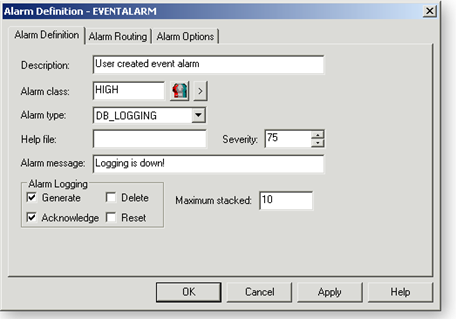Step 2. Configure an Event Alarm

Fill in the fields as follows.
| Field | Description |
|---|---|
| Description | Describes the alarm so a user can identify it more easily. Can display in the Workbench and the Alarm Viewer. |
| Alarm Class | Selection groups this alarm with alarms that have similar characteristics. |
| Alarm type | Identifies the application with which the alarm is associated. |
| Help file | A text help file that users can display when they click the Help button in the Alarm Viewer. |
| Severity | A number from 1 through 1000. The higher the number the more severe the alarm is considered. CIMPLICITY treats more severe alarms with a higher priority. Note: The Severity for the Alarm String Index must conform to the OPC UA specification guidelines. If you are using Web HMI with CIMPLICITY, be sure to read the "Alarm Microservice" topic or search for "alarm severity" in the Web HMI documentation. It's important to configure this severity correctly so that you get the results that you want to see in Web HMI. For example, events of high urgency can be mapped into the OPC severity range of 667-1000, events of medium urgency can be mapped into the OPC severity range of 334 to 666, and events of low urgency can be mapped into the OPC severity of 1 to 333. |
| Alarm message | Message that displays in the Alarm Viewer when the alarm displays. |
| Alarm Logging | Check if and when you want an event alarm to be logged in the Alarm Logging box on the Alarm Definition tab. You can select any or all of the options:
|
| Maximum stacked | Enter a number between 0 and 20. Note: Maximum stacked treats event alarms the same way as it does point alarms. |
Note: Many fields on the Alarm tab in the Alarm Definition dialog box is the same as the Advanced Alarm tab in the Point Properties dialog box.




